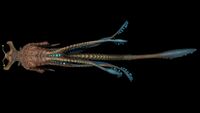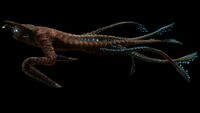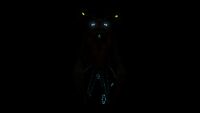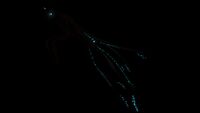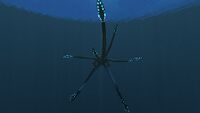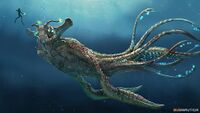Sea Emperor Leviathan: Difference between revisions
GemmaBeepo (talk | contribs) No edit summary Tags: Visual edit apiedit |
AVI761 Delta (talk | contribs) (→Story) Tags: Visual edit apiedit |
||
| Line 20: | Line 20: | ||
== Story == |
== Story == |
||
The captive '''Sea Emperor''' is the last remaining adult of its species. and a mother of [[Sea Emperor Eggs|five eggs]]. These eggs must be hatched at some point in the story. She is over one thousand years old, and is suggested to have far surpassed her natural lifespan |
The captive '''Sea Emperor''' is the last remaining adult of its species. and a mother of [[Sea Emperor Eggs|five eggs]]. These eggs must be hatched at some point in the story. She is over one thousand years old, and is suggested to have far surpassed her natural lifespan. |
||
Almost all of the '''Sea Emperors''' died when the [[Carar]] was released, leaving one remaining adult which was later discovered to be pregnant and laid five eggs. As the only source of [[Enzyme 42]] on the planet, the '''Sea Emperor''' and her children are the key to curing Carar. |
Almost all of the '''Sea Emperors''' died when the [[Carar]] was released, leaving one remaining adult which was later discovered to be pregnant and laid five eggs. As the only source of [[Enzyme 42]] on the planet, the '''Sea Emperor''' and her children are the key to curing Carar. |
||
Revision as of 04:25, 18 December 2016

|
This seems new This article contains information that is updated for the latest Experimental Version of Subnautica. Players using stable mode may find this information inaccurate. |
Of the specimens on record, only one survived infection with the bacterium. The closest translation of their symbol for this specimen would be 'emperor'.
― PDA, Data Downloads
The Sea Emperor is a life form belonging to the fauna category. It is still under development, and is only spawnable by using the Debug Console Commands.
Once fully implemented, the Sea Emperor will be the largest creature in the game.
Appearance
The Sea Emperor is colossal in size, having a stocky body entirely armored and predominantly pale brown in color, with a few shades of green. Its tentacles are adorned with bright cyan bioluminescent spots.
The creature's head is small, and quite peculiar in shape (see "Trivia" below for more), featuring two glowing green-tipped antennae on top of its snout, two large mandibles on each side of its rather small mouth, and a glowing hollow in-between these mandibles. It seems to possess four binocular eyes.
The Sea Emperor's posterior consists of seven long, yet slim tentacles ending with large tentacular clubs, with the largest being in the center, surrounded by the other smaller ones.
Unlike the Sea Dragon Leviathan, the Sea Emperor doesn't have true graspers; Instead, its forelimbs are two massive, paddle-like arms.
Behavior
Despite its gargantuan size, the Sea Emperor's diet consists solely of micro-organisms filtered from the water.
It is suggested that in the past these creatures would have traveled in small herds, occasionally coming to the surface to feast on the microorganisms in the shallower water. When the Carar bacterium was released onto the planet, billions of creatures died, destroying the food source of the species.
Story
The captive Sea Emperor is the last remaining adult of its species. and a mother of five eggs. These eggs must be hatched at some point in the story. She is over one thousand years old, and is suggested to have far surpassed her natural lifespan.
Almost all of the Sea Emperors died when the Carar was released, leaving one remaining adult which was later discovered to be pregnant and laid five eggs. As the only source of Enzyme 42 on the planet, the Sea Emperor and her children are the key to curing Carar.
When the Carar was released, the Precursors captured the only surviving Sea Emperor and contained her in the Primary Research Facility due to the life forms' immunity to the virus. The last surviving Sea Emperor was studied by the Precursors in hopes of finding a cure using her natural production of Enzyme 42. However, due to her age, studies conducted that she was not a viable source of Enzyme 42 as the enyzme she produced was too unstable. Precursor documents state that she had "grown sick", and is later revealed that she was pregnant. After the Sea Emperor gave birth to five eggs, the Precursors took her eggs and attached them to the Precursor Egg Incubator, as the conditions of the aquarium were not suitable for her eggs to hatch, and the juveniles may be a better source of Enzyme 42. Later, creatures indirectly brought seeds from Flora and terrain into the aquarium, transforming the aquarium into a thriving ecosystem. With the Sea Emperor producing enough Enzyme 42 to keep the creatures inside immune. In turn, the creatures learned to protect the Sea Emperor, and she began thriving off of them.
Data Bank Entries
<tabber> Data Bank Entry=
|
SPECIMEN SIZE CATEGORIES HAVE BEEN ADJUSTED UPWARD TO ACCOMMODATE THIS SPECIES
|
|-| Life Cycle=
|
Available biological data has been used to synthesize the effects of the alien bacterium on the sea emperor's natural lifecycle.
|
</tabber>
Future Plans
- Juvenile Sea Emperors and Sea Emperor eggs will be added in the future.[1]
- The Sea Emperor will produce Enzyme 42 which will cure fauna and the Player of Carar
- Given this, it is most likely that the Sea Emperor is immune to the Carar.
- The Sea Emperor may communicate telepathically with the Player about why they need to hatch her eggs.[2]
Gallery
<tabber> In Game Screenshots=
|-| Videos=
- Emp leviathan idle 01
Idle animation
- Emp leviathan fixes and additions 03
More animations
|-| Concept Art=
</tabber> For a more complete gallery, visit Sea Emperor/Gallery
Trivia
- The Sea Emperor currently uses the AI of the Boneshark and lacks certain animations. It can attack, inflicting 80% damage to the player's health.
- Once fully implemented, the Sea Emperor will be upscaled to be larger than the Sea Dragon Leviathan[3][4] and it will become the largest life form in the game.
- Certain developmental notes refer to the Sea Emperor as the "Emperor Leviathan"[5].
- Various documents refer to the Sea Emperor as the "Grand Leviathan".
- The Sea Emperor closely shares many of its features to real life animals: a head shape slightly similar to that of many hammerhead sharks, and paddle-like arms, resembling those of the green sea turtles.
- The databank entry suggests that the last surviving Sea Emperor was kept alive well beyond its natural lifespan using unknown technologies, leaving heavy internal and external scarring (possibly even having led to its suggested infertility).
- The Sea Emperor is named after the closest translation the PDA could find for a Precursor symbol. This technically makes it the only creature not named by the Player/PDA.
- The captive Sea Emperor is a female.
- This was teased before being revealed on a Trello card, with Scott "Obraxis" MacDonald jokingly referring to it as the "Sea Empress"
- Despite being a female, the captive Sea Emperor is referred to as "Sea Emperor" rather than "Sea Empress" [6].
- This is because the species is named the Sea Emperor, the last one happens to be female.
- The opening sentence of the data bank entry suggests that Sea Emperors are the largest identified species in the Subnautica universe.
References
- ↑ https://trello.com/c/l7XOXp0o/5508-baby-sea-emperor-scale-attemptsDated June 22, 2016.
- ↑ https://trello.com/c/XJ3CZkAa/5862-barebones-first-playable-story-spoilers
- ↑ http://imgur.com/ajtv3aP Date unknown.
- ↑ http://steamcommunity.com/app/264710/discussions/0/490123197954537523/ Dated October 18, 2015.
- ↑ https://trello.com/c/37zdy3CI/4561-emperor-leviathan-animations Dated June 16, 2015.
- ↑ http://m.imgur.com/sOuJShk Dated September 29, 2016.
Lua error in package.lua at line 80: module 'Dev:Navbox' not found.


